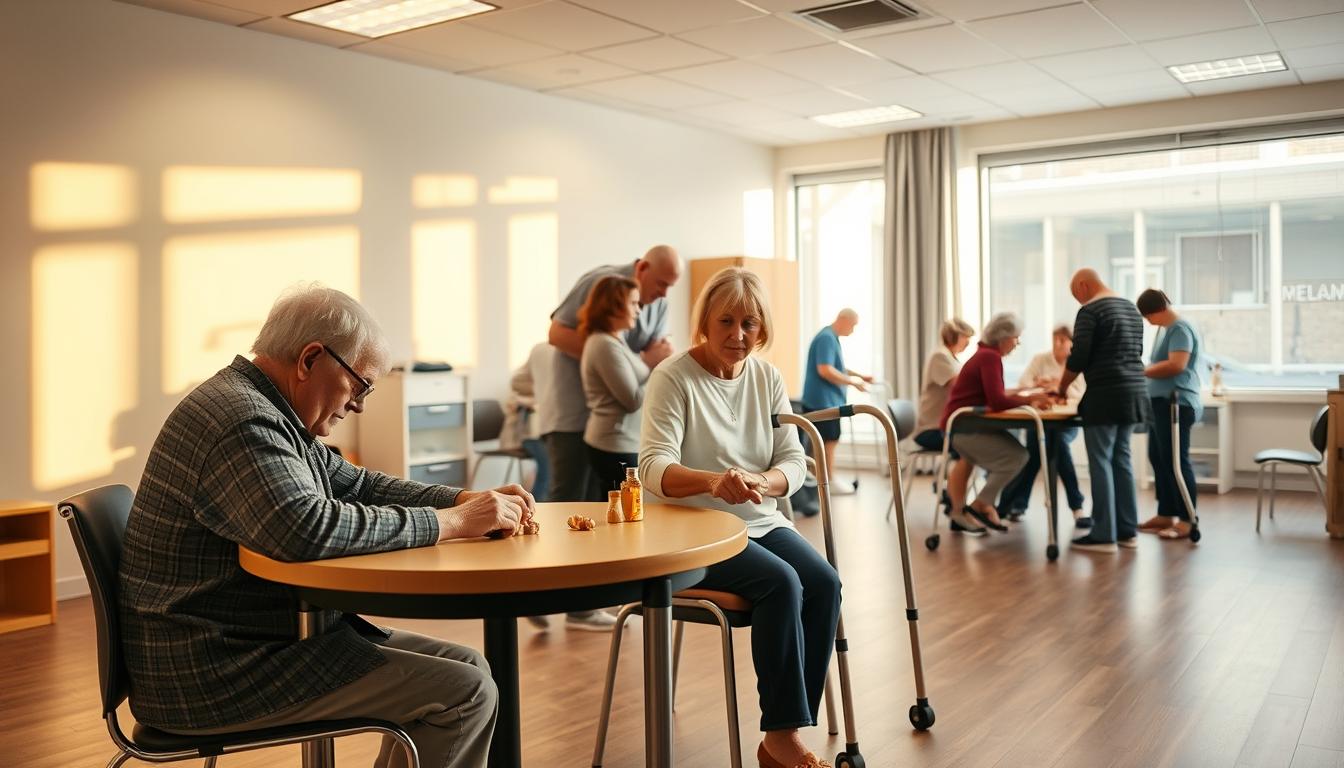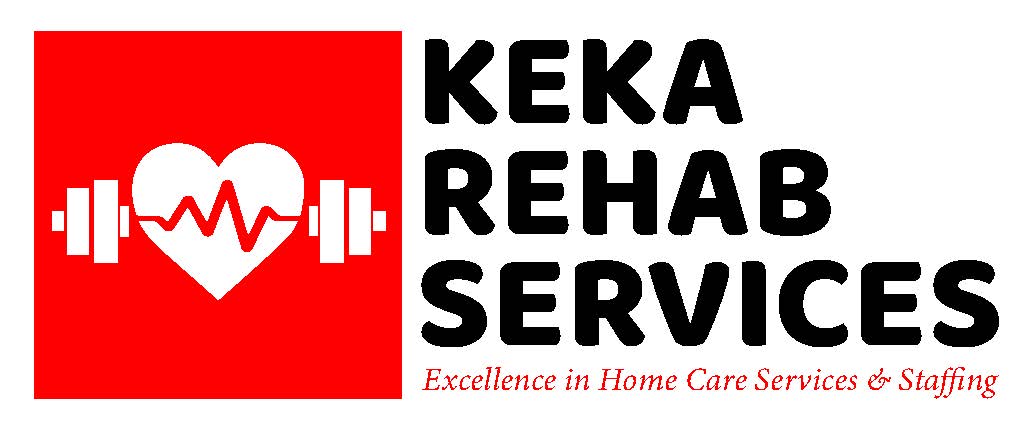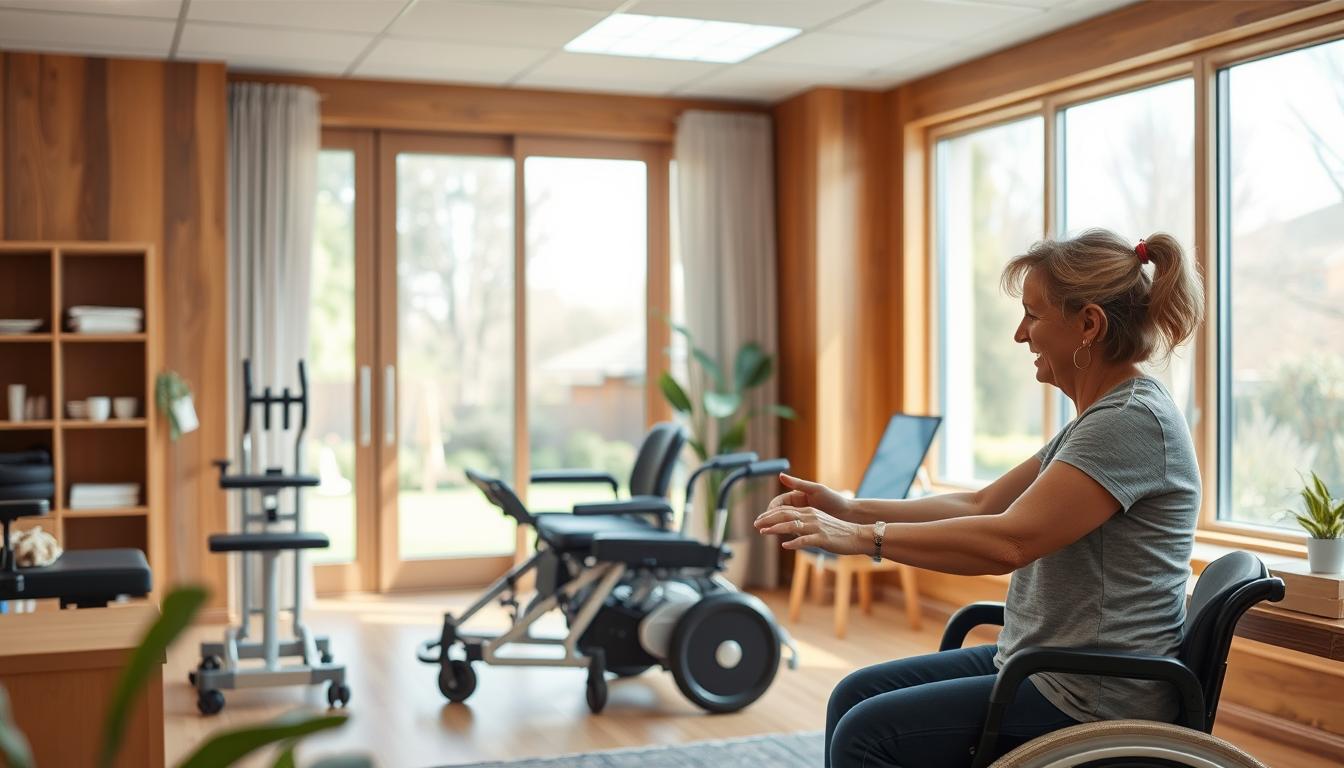Occupational therapy helps individuals regain independence in daily tasks. It focuses on improving self-care, work, and social skills. This type of therapy is beneficial for people with various medical conditions, including brain injuries, mental illnesses, and developmental disorders.
An occupational therapist works closely with patients to set goals and monitor progress. They use exercises, strategies, and modifications to enhance independence. Whether in hospitals, clinics, or homes, these professionals provide flexible and effective care.
Occupational therapy addresses challenges like fine motor skills and sensory processing in children. Studies show that children who receive this therapy improve their ability to perform daily tasks by 50%, making it a vital resource for families and educators.
Key Takeaways
- Occupational therapy enhances independence in daily activities.
- It benefits individuals with brain injuries, mental illnesses, and developmental disorders.
- Occupational therapists use exercises and modifications to improve skills.
- Children with developmental delays show significant improvement with therapy.
- This therapy is available in various settings, including homes and clinics.
Introduction to What is Occupational Therapy
Our approach to occupational therapy centres on empowering individuals through personalized care. We believe every person has unique needs, and our goal is to help them regain independence daily. We create strategies that promote overall health and wellbeing by focusing on routines and activities.

Defining Our Approach to Occupational Therapy
Our methods are client-centred, meaning we tailor interventions to fit each individual’s goals. Whether it’s recovering from an injury or managing a chronic condition, our strategies are designed to address specific challenges. This approach ensures that every person feels supported and empowered throughout their journey.
The Role of Daily Activities in Health
Daily activities play a critical role in maintaining and improving health. From dressing to grocery shopping, these routines are essential for independence. Our therapists work closely with clients to enhance their ability to perform these tasks using therapeutic techniques and scientific principles.
For example, we might introduce assistive equipment or exercises to improve strength and coordination. These interventions are not just about recovery; they’re about helping individuals thrive in their everyday lives.
By integrating these strategies into daily routines, we see significant physical and mental health improvements. This holistic approach ensures our clients achieve their goals and enjoy a better quality of life.
What is Occupational Therapy?
Meaningful activities shape our ability to live fully and independently. These tasks, often called “occupations,” include dressing, shopping, and using assistive equipment. Focusing on these routines, we help individuals regain confidence and function daily.

Environmental factors play a crucial role in enhancing independence. Whether it’s adapting a home or workplace, we ensure the surroundings support optimal function. This approach is tailored to each individual’s needs, making it practical for children and adults.
Clarifying the Basics
Our methods focus on personalized interventions that address specific challenges. For example, we might introduce exercises to improve strength or recommend assistive devices. These strategies are designed to help individuals thrive in their everyday activities.
Interventions for children frequently focus on addressing developmental delays and sensory processing challenges. By fostering a nurturing atmosphere, we support them in developing crucial skills for school and play. This flexibility guarantees that our methods are effective for all age ranges.
We also emphasize the importance of teamwork. Collaborating with families, caregivers, and other professionals ensures a holistic approach to care. This integrated method leads to better outcomes and a higher quality of life.
History and Evolution of Occupational Therapy
The roots of therapeutic practices trace back to ancient civilizations, where activities were used to heal and restore. Early evidence shows that engaging in meaningful tasks was a cornerstone of recovery, even in ancient Greece and Egypt. These practices laid the groundwork for modern methods.
Early Beginnings and Origins
In the 19th century, moral treatment emerged as a key approach, emphasizing the importance of daily activities in psychiatric care. This philosophy highlighted the value of work and productive tasks in improving mental health. By the early 20th century, arts and crafts became central to therapeutic workshops addressing physical and mental challenges.
Key Milestones in Development
World War I was pivotal, highlighting the increasing demand for rehabilitation services. In 1917, the National Society for the Promotion of Occupational Therapy was established, officially launching the profession. Influential figures such as Eleanor Clarke Slagle significantly contributed to its development. With World War II, the focus broadened to encompass soldiers suffering from orthopaedic and psychiatric issues, reinforcing the field’s significance.
Over time, treatment settings evolved from home-based environments to clinical and community spaces. The 1963 Community Mental Health Act shifted services toward community participation, emphasizing long-term independence. These practices continue to adapt today, addressing diverse needs across all age groups.
Key Principles and Theories Behind the Practice
Effective care begins with recognizing each individual’s specific needs. We emphasize client-centered strategies that leverage strengths and tackle distinct challenges. This method guarantees that every patient feels supported and empowered during their journey.
Client-Centered and Strengths-Based Approaches
We prioritize the individual’s goals and abilities, tailoring interventions to their needs. For example, a patient recovering from an injury might receive exercises to improve strength and coordination. Studies show that 70% of practitioners use this method, leading to better outcomes.
Our strategies also emphasize the importance of cultural relevance. The Kawa Model, for instance, highlights how life’s flow and barriers affect engagement. This ensures that care is inclusive and effective for diverse populations.
Integration of Science and Personalized Care
Scientific research plays a vital role in shaping our methods. Models like the Canadian Model of Occupational Performance and Engagement (CMOP-E) guide our practice. These frameworks help us address physical, emotional, and environmental factors.
The occupational adaptation model (OAM) has increased adaptive responses in patients with chronic conditions by 50%, illustrating the effectiveness of the theory in practical applications.
Combining science with personalized care ensures that every intervention is effective and meaningful. This holistic approach helps individuals thrive in their daily lives.
The Occupational Therapy Process: Assessment, Intervention, and Evaluation
Enhancing daily life skills involves a structured three-step approach: assessment, intervention, and evaluation. This systematic method ensures everyone receives personalized care tailored to their unique needs and goals.
Comprehensive Initial Assessment
Every journey begins with a thorough evaluation. During this stage, therapists identify baseline performance and pinpoint areas of difficulty. Standardized tools are often used to measure a client’s abilities, ensuring accuracy and reliability.
For example, assessments like the Activities of Daily Living (ADL) Index help gauge independence in tasks such as grooming and mobility. These evaluations provide a clear picture of the individual’s condition and guide the development of targeted goals.
Tailored Interventions for Success
Once the assessment is complete, therapists design evidence-based interventions. These strategies focus on improving specific skills and addressing the individual’s condition. Whether strength-building exercises or adaptive techniques are involved, every plan is customized for success.
Therapists also incorporate meaningful activities into the process. This ensures that clients regain function and enjoy a better quality of life. The therapist’s help is crucial in implementing these strategies effectively.
Ongoing Evaluations and Outcomes
Progress is continuously monitored through regular evaluations. These check-ins allow therapists to adjust interventions based on the client’s experience and changing needs. Tools like the Modified Barthel Index (MBI) track improvements in daily activities.
At discharge, therapists assess overall progress and outcomes. This final evaluation highlights the achievements made throughout the process and ensures clients are ready to thrive independently.
Areas of Practice and Settings
Therapeutic interventions are provided in various settings to address patients’ individual needs. These environments include hospitals, clinics, schools, and homes, each necessitating customized strategies for effective care.
Hospital and Clinic Environments
Nearly half of practitioners work in hospitals or clinics that address acute and chronic conditions. Therapists focus on helping patients regain independence through structured exercises and adaptive techniques in these settings. For example, post-surgery rehabilitation often involves strength-building activities to improve mobility.
Clinics, especially outpatient facilities, often see higher cancellation rates due to patients not living on-site. Despite this, therapists provide consistent care, ensuring progress toward recovery goals.
Community, School, and Home Settings
Therapists assist children facing developmental delays or sensory processing challenges in schools and community settings. They collaborate with educators to develop tailored plans that foster academic success and social engagement.
Home-based care is particularly vital for older adults or those recovering from injuries. Therapists use assistive devices and modifications to adapt homes to enhance safety and independence. This approach ensures that individuals can thrive in their daily lives.
Practitioners facilitate change by addressing physical, emotional, and environmental factors across all settings. For instance, their work in mental health settings focuses on improving coping skills and daily functioning.
Working with Different Populations
Our methods adapt to support individuals at every stage of life, from childhood to older adulthood. We focus on enhancing independence and well-being through tailored interventions. This approach ensures that everyone, regardless of age or background, can thrive in their daily occupation.
Children, Youth, and Educational Settings
For children and youth, we address developmental delays, sensory processing issues, and learning disabilities. In educational settings, we collaborate with teachers to create individualized plans. These strategies support learning, social participation, and overall growth.
For example, we might introduce sensory integration techniques to help children focus in the classroom. These methods are designed to build essential skills for school and play. By adapting our practice to meet their needs, we ensure meaningful progress.
Adults and Older Adult Care
Our customized strategies benefit adults recovering from injuries or dealing with chronic conditions. We emphasize enhancing strength, coordination, and everyday functionality. In community environments, we assist older adults in preserving their independence using adaptive methods.
For example, we may suggest assistive devices or modifications to the home to improve safety. These measures aim to encourage healthy ageing and reduce the risk of falls. Our therapy efforts guarantee that each person can flourish in their surroundings.
We address challenges at every phase by connecting with people across the lifespan. This holistic approach ensures that our interventions are effective and meaningful.
Role of the Occupational Therapist
Occupational therapists are essential in supporting individuals in tackling challenges in their everyday lives. They aim to enhance skills necessary for self-care, employment, and social interactions. Whether they work with children, adults, or seniors, they aim to boost independence and improve overall quality of life.
Daily Responsibilities and Interventions
Practitioners evaluate their clients’ needs daily and create tailored interventions. These interventions might involve activities to enhance strength, coordination, or cognitive abilities. For instance, in educational environments, therapists assist children with developmental delays in developing crucial skills for learning and play.
Therapists assist patients recovering from injuries or managing chronic conditions in hospitals and clinics. They recommend assistive devices like walkers or wheelchairs and provide training for caregivers. These interventions ensure that individuals can perform daily tasks safely and independently.
Interdisciplinary Collaboration and Advocacy
Collaboration is a cornerstone of adequate care. Therapists work closely with educators, healthcare providers, and families to create holistic plans. In community settings, they advocate for changes that promote accessibility and inclusion.
Advocacy efforts also focus on occupational justice, ensuring everyone can access meaningful activities. Practitioners educate policymakers and the public about the importance of their work. This advocacy helps shape policies that improve the quality of life for diverse populations.
Occupational therapists create a lasting impact through daily interventions, collaboration, and advocacy. Their efforts enable individuals to succeed in every facet of life.
Educational Pathways and Certification Requirements
Becoming a skilled professional in this field requires a structured educational journey and rigorous certification. We guide individuals through the steps needed to excel in this rewarding career. From degree programs to licensure, every phase is designed to prepare practitioners for success.
Degree Programs and Occupational Therapy Education
Aspiring professionals usually start by earning a bachelor’s degree in biology or health science. After completing this essential step, they typically pursue a master’s or doctoral program, which may last two to three years. Additionally, combined programs enable students to obtain both degrees in as few as five years.
Specialized pathways, such as the OTA Pathway, enable licensed occupational therapy assistants to advance their education. These programs emphasize hands-on learning and clinical experience, ensuring graduates are well-prepared for practice.
Licensure, Supervised Internships, and Certification
After completing their education, individuals must pass the National Board for Certification in Occupational Therapy (NBCOT) exam. This rigorous test assesses knowledge and skills essential for effective practice.
Supervised internships play a vital role in the training process. These experiences offer practical learning opportunities, enabling individuals to utilize their knowledge in various environments. While licensure requirements differ by state, they typically involve ongoing education to uphold credentials.
By committing to ongoing learning and professional development, practitioners ensure they remain at the forefront of their field. This dedication to excellence benefits both individuals and the communities they serve.
Benefits of Occupational Therapy for Patients
Focusing on meaningful daily activities, we help individuals regain independence and improve their quality of life. Our services are designed to address physical, emotional, and social goals, ensuring tailored care for every patient.
Enhancing Independence and Everyday Function
We prioritize helping patients regain functional independence through targeted interventions. For adults recovering from injuries or managing chronic conditions, we develop personalized plans that focus on essential skills like self-care and mobility.
For example, we may recommend adaptive equipment such as handrails or shower stools to maintain safety at home. These tools, combined with skill-building exercises, can significantly improve daily tasks.
Improving Overall Quality of Life
We offer services beyond physical recovery, aiming to improve emotional well-being. Research indicates that 90% of patients experience a better quality of life after engaging in our programs. Our approach addresses both immediate requirements and long-term objectives.
For older adults, we focus on fall prevention and home modifications, reducing risks by up to 50%. These strategies ensure that individuals can thrive in their environments and maintain independence and confidence.
Combining skill-building with individualized care creates sustainable benefits that empower patients to live fully and independently.
Integrating Occupational Therapy in Daily Life
Adaptive strategies can transform daily routines into opportunities for growth and independence. Individuals can enhance their functionality and overall well-being by incorporating practical techniques into everyday activities. Whether at home or work, these methods optimize performance and foster independence.
Practical Strategies at Home and Work
Our emphasis is on developing spaces that promote safety and independence. For instance, installing home features such as grab bars and tub benches can lower fall risks by as much as 50%. These enhancements allow individuals to carry out daily activities with assurance.
We suggest using ergonomic tools and adaptive equipment in professional environments to enhance productivity. By customizing these solutions to fit individual requirements, we empower clients to excel in their careers.
Using Adaptive Techniques and Tools
Adaptive tools like handrails and grabbers enhance functionality and safety in daily tasks. These devices compensate for physical limitations, enabling individuals to maintain independence.
We also emphasize the importance of education and training. By teaching clients how to use these tools effectively, we empower them to navigate daily challenges easily.
Our approach ensures that every adjustment contributes to better treatment outcomes, regardless of the setting or state of the individual’s condition.
Future Trends and Innovations in Occupational Therapy
Innovative practices and advanced technology are redefining the future of care. We’re seeing a shift in creating and implementing interventions, emphasizing accessibility, personalization, and efficiency. These developments are improving patient outcomes and changing healthcare practitioners’ roles.
Emerging Practices and Technological Advances
Technology is pivotal in shaping the future of care. Telehealth, for instance, is making services more accessible, especially for patients in rural areas. This approach eliminates travel, ensuring that care is delivered efficiently.
Virtual Reality (VR) and Augmented Reality (AR) are also gaining traction. These tools are particularly effective in enhancing social skills and communication in children with autism spectrum disorders. By incorporating gamification, they increase patient motivation and adherence to treatment protocols
Wearable devices are another innovation that is transforming the field. They allow for real-time monitoring of health metrics, enabling therapists to evaluate treatment effectiveness and modify plans as needed. This data-driven approach ensures that interventions are tailored to individual needs.
Anticipating Changes in Health Care Settings
The shift towards preventive care is reshaping healthcare settings. Programs focused on health promotion are gaining prominence, with the potential to reduce injury rates in workplace environments. This proactive approach aligns with our goal of enhancing overall well-being.
Collaboration with architects and urban planners is also on the rise. By creating more accessible environments, we cater to a broader range of abilities and needs in the community. This holistic approach ensures that everyone can thrive in their daily lives.
As technology evolves, we prepare for a future where tasks and assessments are more efficient and effective. By embracing these changes, we are setting new standards for care and ensuring better outcomes for all.
Conclusion
Through tailored interventions, we empower individuals to achieve greater independence in their daily lives. This guide has highlighted the importance of a solid educational foundation and ongoing professional development for practitioners. A degree in this field opens doors to meaningful careers while the role of a therapy assistant continues to evolve, offering vital support in diverse settings.
Our focus on personalized care ensures that patients and their families benefit from improved functionality and quality of life. We create sustainable solutions that foster independence and well-being by addressing physical, emotional, and environmental factors.
As the field advances, we remain committed to integrating innovative practices and technology to enhance patient outcomes. This comprehensive guide is a stepping stone for deeper understanding and engagement, empowering individuals to thrive daily.



